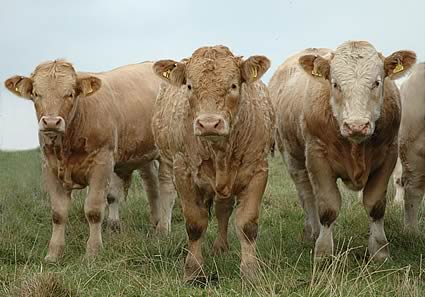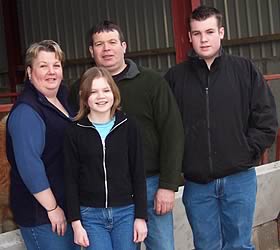 |
|||||||||
|
|||||||||||||||||||
|
|
Charolais
Cross Breeds Optimism 03/03/06 Edwin and Joyce Holliday are among a growing number of beef producers who are aware that growth rate is a trait of increasing importance to the sector.
“We know we can’t influence the price p/kg we are paid, however what we can do is improve our herd’s performance efficiency within the new regime,” said Edwin Holliday. “We have to maximise the quantity of saleable meat produced within the shortest time period and market a beast with superior eating quality that consistently meets market demand.” The Hollidays are demonstrating they can already deliver at Cleamire, a DA/SDA owner occupied unit amounting to almost 500 acres at Westward, near Wigton. Charolais cross bulls reared from their 105 cow suckler herd are finished within 12 months to 600kg target live weight and traded through Hopes Auction at Wigton. Last year the entire crop sold to average £674 to repeat buyers mainly for multiples. That packet included a first prize winner who weighed in at 730kg, achieved 1.35kg DLG and made £950. “We’ve been finishing home bred Charolais cross bulls for more than 20 years, simply because there’s a higher margin to be had than steering them and trading through the store ring or finishing extensively at 18 months. Furthermore, getting the bulls away at 12 months has freed up grazing land enabling us to expand the sheep enterprise from 800 to 1,000 ewes resulting in additional income from 350 Texel cross and Beltex cross finished lambs.” In contrast, the Hollidays have a ready demand for 18 month finished Charolais cross heifers from local butchers. In 2005, they were traded at an average 540kg through Hopes Auction to average £650, and went on to kill out at an average 63pc and grade in the U+ bracket. “We’re satisfied that our enterprise will remain sustainable under the new regime and we are quietly optimistic for its future,” said Edwin. “Beef producers have in general been through a tough patch in the last nine months, and are now facing the uncertainty of the OTMS market, however we believe within the next two years quality beef from the suckler herd will become scarce as it begins to reflect the number of producers who have decided to down size or quit, and GB could be down to 60pc self sufficiency in home produced beef.” The Holliday’s confidence is to a degree reflected in the new finishing accommodation for 75 head they’ve been building this winter. Assisted by a Rural Regeneration Cumbria grant, the shed features straw bedded yards, various welfare and safety aspects and an open front with troughs, enabling the beasts to be fed for the first time with a feeder wagon.
Furthermore, their family has a keen involvement in the business; 12 year old daughter, Joanne regards helping out with the cattle and sheep a priority at weekends, while their 16 year old son, Edwin juggles his full time studies for a National Diploma in Agriculture at the University of Central Lancashire, Newton Rigg while helping out on the farm at both ends of the day and offering new technical and business ideas for discussion. “We’ve been working for example, with Keenan’s nutritionist to formulate a more finely tuned TMR diet through the new feeder wagon which will ultimately help us to further exploit our Charolais cross bull’s growth potential,” he explains. It was Edwin junior’s great grandfather, Ted Holliday who made the progressive step to introduce Charolais as the beef enterprise’s terminal sire more than 35 years ago. “He initially identified the breed in the commercial ring leaving beasts with superior weight for age and conformation and he wanted a slice of the action too. A decision was made to swap our native breed of terminal sire for Charolais, and since then we’ve never looked back. Weight continues to pay.” The Hollidays have also backed the Charolais breed by establishing a small pedigree herd which they eventually plan to develop to produce breeding stock. “We select our stock bulls on overall conformation and length, and we take in to account their Estimated Breeding Values in particular for 400 day weight and muscle score. Our current two stock bulls, Border Riever and Hallbankgate Union Jack are leaving the type of cattle we’re seeking, they’ve growth and length, and they’re clean through the belly. We also appreciate their quiet temperament. “All herd replacements are bought in as heifers with calf at foot, and we always find a noticeable difference in the performance of these Continental crosses compared with our homebred cattle. Both our Charolais cross bulls and heifers reach target weight between two and five weeks earlier and they finish 50kg heavier.” The suckler herd calves in spring enabling both cows and Charolais cross calves to maximise the use of grazed grass from turnout. To ease the weaning transition period, the bulls are introduced to proprietory creep six weeks prior to weaning and housing in November after which they are fed a TMR comprising locally grown rolled barley and straw, together with dark distillers grains, molassed sugar beet pulp and soya from local merchant, J Stobart and Sons. The heifers introduced to a similar diet on weaning and fed at a lower rate through to turn out in April, after which they grazed through to target weight. “In future, we plan to continue to improve the farm’s efficiency and keep an eye on the marketplace to make sure we deliver exactly what it wants. Our new shed and the opportunity to feed more finely tuned diets, combined with exploiting today’s advanced Charolais genetics, will contribute towards our goal to maintain a sustainable and profitable family hill farm.”
| ||||||||||||||||||

|
|
||||||||||||||||||
| home | agri-services | pedigree
pen | news | dairy | beef | machinery property | organisations | site map |
|||||||||||||||||||

